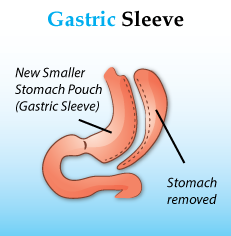Gastric Sleeve
-
Content written by Andrew Proulx, MD | Reviewed by EnhanceMyself Medical Team | Last updated 6/12/2023
- Overview
Overview
What is gastric sleeve?
Gastric sleeve, also known as a sleeve gastrectomy, is a type of bariatric (weight-loss) procedure. It involves removing a large portion of the stomach, leaving behind a smaller, sleeve-shaped stomach that resembles a banana or a sleeve. The procedure is performed laparoscopically, using small incisions and a camera-guided instrument called a laparoscope.
Cost of gastric sleeve surgery
The average cost of gastric sleeve surgery is between $10,000 to $25,000. There are several factors can affect the cost of gastric sleeve surgery. These factors include:
- Your Bariatric Surgeon: The experience and reputation of your bariatric surgeon can affect the cost of your procedure. Usually, surgeons with extensive training or specialization charge higher fees.
- Location Matters: Where the medical practice is located can impact the cost. Bariatric practices in urban areas or regions with a higher cost of living often come with a heftier price tag compared to rural areas.
- Type of Procedure: Different bariatric procedures have varying costs. Gastric sleeve surgery, gastric bypass, adjustable gastric banding, and duodenal switch are among the commonly performed procedures.
- Anesthesia: The administration of anesthesia involves the expertise of an anesthesiologist. The type of anesthesia used, the duration of the procedure, and the qualifications of the anesthesia provider influence the anesthesia fees.
- Surgical Facility: Different facilities have varying levels of accommodations and amenities which can affect the overall price.
- Complexity of the Case: The complexity of your case can make a differece. Cases that require significant work may require more advanced treatment techniques and additional time.
- Pre and Postoperative Care: The care provided before and after affects the overall cost. This includes preoperative consultations, medical tests, prescription medications, and follow-up appointments.
- Insurance: Gastric sleeve surgery may be covered by insurance if it’s deemed necessary if certain criteria are met.
If you are considering gastric sleeve surgery, schedule a consultation with an experienced bariatric surgeon near you. This will allow you to discuss your weight loss goals and obtain a better understanding of the specific costs that pertain to your individual case.
Are you a candidate?

- High Body Mass Index (BMI): A BMI of 40 or higher (severe obesity), or a BMI of 35 or higher with obesity related health conditions such as type 2 diabetes.
- Failed Attempts at Weight Loss: You have made several attempts to lose weight but have not achieved significant and sustained weight loss.
- Overall Health: Being in good overall health is essential. You should be physically fit enough to undergo a major surgical procedure.Commitment to
- Lifestyle Changes: Remember, gastric sleeve surgery isn’t a quick fix. You should be committed to making long-term changes to your diet and lifestyle. This means embracing healthy eating habits, incorporating regular physical activity, and staying dedicated to follow-up medical care.
- Psychological Evaluation: A psychological evaluation showing your mental and emotional prepared for surgery and willingness to follow post-operative recommendations.
- Understanding of Benefits & Risks: It’s important to fully comprehend the potential advantages, drawbacks, and lifestyle changes associated with gastric sleeve surgery. Being well-informed is key when making this important decision.
You may not be a good candidate if you have any of the following conditions:
- Uncontrolled bleeding disorder
- Severe psychiatric illness (e.g. depression, psychosis, etc.)
- Negative reactions to general anesthesia
- Gastroesophageal reflux disease (GERD)
- Barrett’s esophagus
- Large hiatal hernia
It’s important to consult with a qualified bariatric surgeon to determine if gastric sleeve surgery is a suitable option for you.
How does it work?

Additionally, the sleeve gastrectomy removes the part of the stomach responsible for producing ghrelin, the hunger stimulating hormone. As a result, appetite is reduced for years after surgery.
Procedure overview
Gastric sleeve surgery is typically done using a laparoscopic approach, which involves making small incisions in the abdomen and using specialized tools for the procedure. Typically, the entire procedure takes around 60 to 90 minutes to complete. Here’s a simplified overview of how it’s done:
- Anesthesia: General anesthesia is given to ensure you are asleep and pain-free during the surgery.
- Incisions: Once the anesthesia takes effect and you are completely unconscious, several small incisions usually ranging from 5 to 12 millimeters in size, are made in the abdomen.
- Laparoscope Insertion: Next a laparoscope, which is a long, thin tube with a camera and light attached, is inserted through one of these incisions. This allows your surgeon to see inside the abdomen on a monitor.
- Stomach Division: During this step, your surgeon will divide the stomach vertically using surgical tools, creating a long, tube-like shape. The larger part of the stomach, which produces the hunger hormone ghrelin, is removed.
- Stapling: Then the remaining stomach is sealed and divided using surgical staples or sutures to create the smaller sleeve-shaped stomach pouch. Your surgeon will check to ensure there are no leaks or bleeding.
- Close Incisions: Finally, the small incisions in the abdomen are then closed up using sutures or surgical staples.
- After Surgery: After your procedure, you are taken to a recovery are where you are closely monitored as you wake up from the anesthesia.
For a more detailed description of how the procedure is performed, visit the National Library of Medicine website.
Recovery time
Following surgery, most patients stay in the hospital for 1 or 2 days before returning home to heal.
It is common to experience pain and swelling in the abdomen after surgery, and your doctor may prescribe pain medication.
Typically, patients return to work within 2 to 4 weeks after surgery, but strenuous exercise and heavy lifting should be avoided for 6 to 8 weeks.
There is a strict diet to adhere to after a sleeve gastrectomy, beginning with sugar-free, noncarbonated liquids for the first week (protein shakes, broth, milk, yogurt, and juice).
Fatigue is common during this time, due to the low-calorie nature of the diet. After this, you will transition to pureed foods for 3 weeks, and finally progress to eating solid foods around 4 weeks after surgery.
Since your stomach cannot absorb as much as it used to, it is important to take multivitamins and calcium to supplement your diet. A vitamin B-12 injection will also be required once a month for life.
One benefit of the sleeve gastrectomy compared to other bariatric surgeries is that most patients are able to continue eating the variety of foods they did pre-surgery; these include fibrous vegetables and meats.
How much weight will you lose?
Patients can expect to lose at least 50% of their excess body weight within 1.5 to 2 years following the surgery. A study found that some patients may lose up to 60% to 70% after five years.
It is common to regain some weight after bariatric surgery. In fact, an estimated 1/5 of patients have regained more than 15% of their body weight 5 years post-surgery. The findings suggest that factors encompassing both one’s internal state and external influences, including psychosocial elements, alterations in appetite, and issues related to physical and mental health, could play a role in the difficulties in maintaining weight control.
It is important to maintain diet and lifestyle changes to keep the weight off.
Alternatives to gastric sleeve
There are other surgical alternatives to the sleeve gastrectomy that can provide similar weight loss benefits. These include:
- Roux-en-Y gastric bypass (RYGB): With gastric bypass surgery, a portion of the stomach is stapled off to form a gastric pouch; the small intestine is then attached in a “Y” formation to the pouch to bypass the lower stomach and intestines.
- Adjustable gastric band: A band is placed around the upper part of the stomach to separate it from the main part of the stomach; the smaller part will fill up with food faster and empty slowly into the rest of the stomach, limiting food intake. An example is the LAP-BAND procedure.
It is important to note that the sleeve gastrectomy is a permanent procedure and cannot be undone. Other options, like the adjustable gastric band and gastric bypass, can be reversed.
EnhanceMyself.com relies on sources such as professional medical organizations, government agencies, academic institutions, and peer-reviewed scientific journals to write it’s articles. Learn more about how we ensure our content is accurate, in-depth, and unbiased by reading our editorial guidelines.
*Medical Disclaimer: This website does not provide medical advice. Read more.

